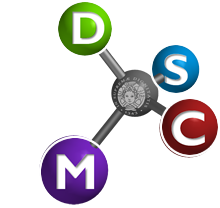
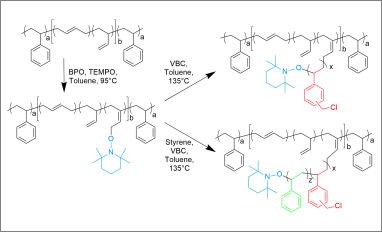 Congratulations to our PhD student Andrea Roggi for his publication entitled "SBS-based AEM for water electrolysis via NMP" in Polymers. Nitroxide Mediated Polymerization (NMP) was employed for the synthesis of VBC/Sty-graft copolymers starting from a commercial thermoplastic elastomer, namely the Styrene-Butadiene-Styrene (SBS) tri-block copolymer. The synthesized copolymers were used for the preparation of Anion Exchange Membranes (AEMs) for water electrolysis after the conversion of the grafted moieties into ionic sites with Trimethylamine (TMA).
Congratulations to our PhD student Andrea Roggi for his publication entitled "SBS-based AEM for water electrolysis via NMP" in Polymers. Nitroxide Mediated Polymerization (NMP) was employed for the synthesis of VBC/Sty-graft copolymers starting from a commercial thermoplastic elastomer, namely the Styrene-Butadiene-Styrene (SBS) tri-block copolymer. The synthesized copolymers were used for the preparation of Anion Exchange Membranes (AEMs) for water electrolysis after the conversion of the grafted moieties into ionic sites with Trimethylamine (TMA).
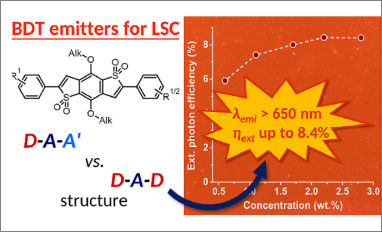 Congratulations to our Ph.D. students Cosimo Micheletti and Alberto Picchi for their scientific publication entitled “Orange/Red Benzo[1,2‑b:4,5‑b′]dithiophene 1,1,5,5-Tetraoxide-Based Emitters for Luminescent Solar Concentrators: Effect of Structures on Fluorescence Properties and Device Performances” in the ACS Applied Energy Materials journal. A series of organic fluorescent emitters bearing an electron-withdrawing benzo[1,2-b:4,5-b′]dithiophene 1,1,5,5-tetraoxide unit as their central core were designed, synthetized, and characterized.
Congratulations to our Ph.D. students Cosimo Micheletti and Alberto Picchi for their scientific publication entitled “Orange/Red Benzo[1,2‑b:4,5‑b′]dithiophene 1,1,5,5-Tetraoxide-Based Emitters for Luminescent Solar Concentrators: Effect of Structures on Fluorescence Properties and Device Performances” in the ACS Applied Energy Materials journal. A series of organic fluorescent emitters bearing an electron-withdrawing benzo[1,2-b:4,5-b′]dithiophene 1,1,5,5-tetraoxide unit as their central core were designed, synthetized, and characterized.
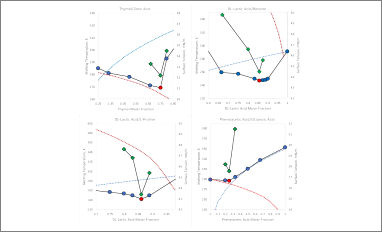 A new publication, with the contribution of our PhD student Elisa Rossi, dealing with DESs singularities at their eutectic point, especially in terms of ionic conductivity and surface tension. The results of this study underline the "entropic driving force" on DESs formation and show the surface tension as an useful technique for determining the eutectic point.
A new publication, with the contribution of our PhD student Elisa Rossi, dealing with DESs singularities at their eutectic point, especially in terms of ionic conductivity and surface tension. The results of this study underline the "entropic driving force" on DESs formation and show the surface tension as an useful technique for determining the eutectic point.
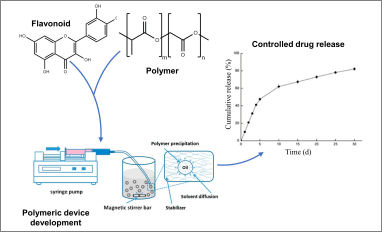 Congratulations to our PhD student Gianni Pecorini for his publication entitled "Polymeric Systems for the Controlled Release of Flavonoids" in Pharmaceutics. In this article the different classes of flavonoids are described together with the polymers most commonly employed for drug delivery applications. Representative drug delivery systems are discussed, highlighting the most common techniques for their preparation. The flavonoids investigated for polymer system encapsulation are then presented with their main source of extraction and biological properties.
Congratulations to our PhD student Gianni Pecorini for his publication entitled "Polymeric Systems for the Controlled Release of Flavonoids" in Pharmaceutics. In this article the different classes of flavonoids are described together with the polymers most commonly employed for drug delivery applications. Representative drug delivery systems are discussed, highlighting the most common techniques for their preparation. The flavonoids investigated for polymer system encapsulation are then presented with their main source of extraction and biological properties.



